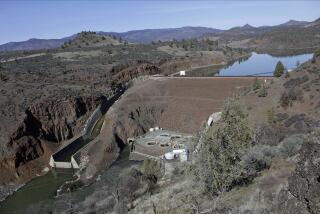THE LATE, GREAT LAKES by William Ashworth (Knopf: $17.95; 320 pp.)
- Share via
Will you abide another anguished tale of environmental woe? Can you tolerate the same old song just one more time if the deed is sufficiently awful, the writing reasonably artful, and much beauty remains? What if we are talking about one-fifth of all the fresh water on Earth: the Great Lakes.
Look at a map of the Earth. Search for vast sweet-water seas like North America’s Great Lakes. You will not find them. The longest continuous coastline of the United States lies along neither the Atlantic nor the Pacific; it is our North Coast with Canada. These “lakes” are so vast that they possess significant tides and exercise great influence over Midwestern weather. Powerful wave-generating storms sometimes drive even large ships to the bottom. The Great Lakes were created--quite recently--by glaciers, and are still geologically and hydrologically active, human intervention notwithstanding.
Taken together, lakes Superior, Michigan, Huron, Erie and Ontario are so huge that we have been tempted to call them limitless. So wished the trappers, loggers, fishermen, sailors, settlers and industrialists who have taken their livelihood from the lakes. It is their compounded error that forms the backbone of William Ashworth’s “environmental history.” Ashworth is an experienced conservation journalist with half a dozen books under his belt, and a respectable appreciation for understatement. He has found a blend of contemporary newswriting, scholarly research, and personal observation that cunningly injects daunting quantities of information into an inviting prose style.
We all know that Lake Erie died a few years back, and then was reborn following a series of environmental reforms. Nice fairy tale, but dangerously misleading. The eutrophication of Lake Erie, caused primarily by excess untreated sewage that loaded the lake with nutrients that in turn generated algae blooms, consumed dissolved oxygen, and killed fish, was significantly reversed beginning about 10 years ago. The Erie disaster provided a great impetus for reducing levels of conventional organic pollutants and phosphates flowing into the lake; these brought some real improvements, but a substantial--and cyclical--rise in water level turned the lake back to blue and restored the fishery. If only life could be that lucky.
The sad list of past insults to the Great Lakes mounts in Ashworth’s book like a Greek tragedy. Trappers found huge riches in beaver pelts during the late 18th Century and drew local Indians into a prosperous fur economy; then the beaver were suddenly exhausted and some of the most powerful and civilized Indian tribes collapsed. Fishermen found gigantic sturgeon, lake trout, huge runs of Atlantic salmon, and delicious Lake whitefish in seemingly limitless quantities. Today, thanks to obscene overfishing, the destruction of spawning streams, the accidental introduction of lampreys and alewives, and chemical pollution, most of the prime fisheries are entirely gone and much of the remaining palatable fish are contaminated and dangerous to eat. In 1835, foresters laid eyes on the fabled North Woods and set about an orgy of timbering unmatched before or since. By the first decades of the 20th Century, the Big Cut was finished: The limitless forests were denuded wastelands, and the wholesale destruction of lake shores and streams sent salmon, chub, pike and whitefish into declines from which they would never recover.
It is no secret that heavy industry isn’t pretty. The blights that are Detroit, Gary, Buffalo are a direct consequence of that wondrous coincidence of great natural resources and an economical means of transporting them. Unhappily, those great engines of national wealth have bequeathed the Great Lakes with a scourge far worse than mere ugliness. The horror of Love Canal is only one dramatic scene in a continuing play: the poisoning of all five lakes by toxic chemicals. A fearsome array of heavy metals and organics lacing both waters and sediments renders some fish unfit to eat, some beaches unfit for bathing, and this critical supply of fresh water increasingly dangerous to drink.
Ashworth says the biggest threat to the future of the Great Lakes is apathy. Apathy permits this national treasure to further deteriorate when it need not. The newest threat to the Lakes is plans by thirsty Great Plains states to replace their disappearing Ogalalla Aquifer with Great Lakes water. Ironically, the Lakes states are banding together to resist this poaching with an energy never exerted against the long history of more local but equally destructive insults. When it comes to managing fisheries, protecting disappearing scenery, and controlling chemical pollution, apathy has ruled the day.
“The Late, Great Lakes” is not all despair. Although designed to reveal what we have lost, Ashworth’s historical accounts are quite moving. His natural history is well-researched and informative in its own right. But his pessimism is contagious.
More to Read
Sign up for Essential California
The most important California stories and recommendations in your inbox every morning.
You may occasionally receive promotional content from the Los Angeles Times.













